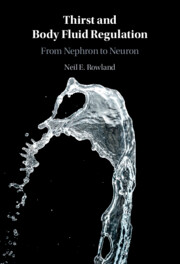Book contents
- Thirst and Body Fluid Regulation
- Thirst and Body Fluid Regulation
- Copyright page
- Contents
- Figures
- Preface
- 1 Fundamentals of Thirst and Body Fluid Regulation
- 2 Body Fluid Compartments, Inputs, and Outputs
- 3 Intracellular Dehydration Thirst and Drinking
- 4 Intracellular Dehydration: Mechanism
- 5 Extracellular Dehydration Thirst and Drinking
- 6 Pregnancy and the Ontogeny of Thirst
- 7 Food-Associated Drinking and Nycthemeral Rhythms
- 8 Hybrid Dehydrations: Water Deprivation
- 9 Hybrid Dehydrations: Thermal Stress and Exercise
- 10 Thirst in Aging and Clinical Populations
- 11 Comparative Aspects of Body Fluid Regulation
- Appendix Methods in Physiology and Neuroscience
- References
- Index
8 - Hybrid Dehydrations: Water Deprivation
Published online by Cambridge University Press: 09 December 2021
- Thirst and Body Fluid Regulation
- Thirst and Body Fluid Regulation
- Copyright page
- Contents
- Figures
- Preface
- 1 Fundamentals of Thirst and Body Fluid Regulation
- 2 Body Fluid Compartments, Inputs, and Outputs
- 3 Intracellular Dehydration Thirst and Drinking
- 4 Intracellular Dehydration: Mechanism
- 5 Extracellular Dehydration Thirst and Drinking
- 6 Pregnancy and the Ontogeny of Thirst
- 7 Food-Associated Drinking and Nycthemeral Rhythms
- 8 Hybrid Dehydrations: Water Deprivation
- 9 Hybrid Dehydrations: Thermal Stress and Exercise
- 10 Thirst in Aging and Clinical Populations
- 11 Comparative Aspects of Body Fluid Regulation
- Appendix Methods in Physiology and Neuroscience
- References
- Index
Summary
Water deprivation or restriction is arguable the most natural of all dehydrations.The magnitude and rate of dehydration depends on the water and electrolyte content of available food, and the extent to which dehydration anorexia mitigates the net dehydrating effect of food.The early stages of water deprivation produce primarily intracellular dehydration, whereas longer durations of deprivation cause progressively greater extracellular fluid losses. Thus, the resulting stimulus to drink is a combination or hybrid of intracellular and extracellular drinking. There are considerable species differences in the rates of postdeprivation drinking and in the mechanisms that terminate such drinking, although in all cases some contribution of preabsorptive controls is evident. The principal structures of the lamina terminalis (OVLT, MnPO, SFO) collectively contribute to postdeprivation drinking, although the relative contribution of these structures may depend on the duration or degree of net dehydration and/or have species differences. Many neurons of the lamina terminalis are excited by both hyperosmolality and ANG II, and so act as integrators, but it has not been established whether the nature of that integration (or threshold) differs between cells within a region, or between regions.
- Type
- Chapter
- Information
- Thirst and Body Fluid RegulationFrom Nephron to Neuron, pp. 139 - 163Publisher: Cambridge University PressPrint publication year: 2021



